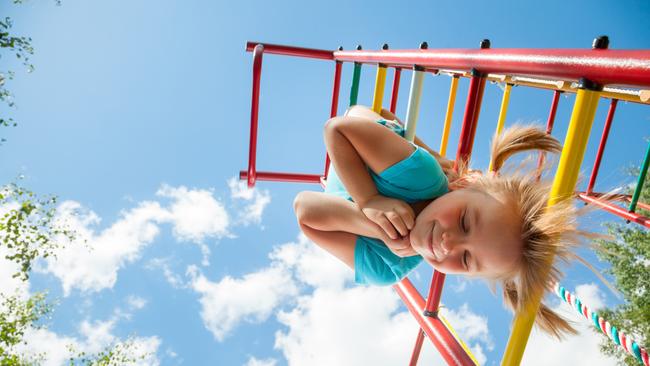What value is childhood without thrills and spills?
In this era of overprotective parenting, Dr Judith Locke fears many children are completely missing out on the chance to do the slightly thrilling but fun activities which used to be a hallmark of past childhoods.
Rendezview
Don't miss out on the headlines from Rendezview. Followed categories will be added to My News.
When was the last time you felt fear?
And I’m not talking fearing not winning the Lotto, or nerves that your favourite team will lose. I mean genuine heart-pumping fear from the excitement of being at a great height, or doing something a little risky like jumping on widely placed stones across a creek?
Recently, I got that experience. On a work trip to Hobart, I had the opportunity to climb the
Truganini track — a 350 metres climb with a slippery mud path and some precariously placed stone stairs leading all the way up to a stunning view of Hobart and the bay around it. It was thrilling to be a little bit terrified, needing to place my steps carefully and, be a little bit alert and alarmed. And it reminded me of being a child doing outdoor physical activity and being a little out of my comfort zone.
But how many children these days are getting the opportunity to climb trees, swing on ropes into the water and clamber up hills? In this era of overprotective parenting keeping children in perfectly safe activities all the time, I fear many children are completely missing out on the chance to do the slightly thrilling but fun activities which used to be a hallmark of past childhoods.

Without this type of activity children are worse off. Educators and psychologists know that kids get great benefits from doing thrilling physical feats. Not only does outdoor play get them active, it makes them more confident of what their body can do. Nothing builds self-esteem like the personal satisfaction of getting up and down the tree, getting across the monkey bar, or climbing to the top of ropes.
More importantly, being active in outdoor activities which are slightly out of their comfort zone helps children learn to cope with tricky feelings such as slight fear, and apprehension.
MORE FROM JUDITH LOCKE: Helping your child thrive is easier than you think
For most of us, we tend to think that any fearful feeling means that there is imminent danger and that we should leave the situation as quickly as we can. Of course, in a dark alley with footsteps behind you that makes sense to seek safety as soon as possible.
But some people have a fear system like a faulty car alarm — it goes off at the slightest tricky situation. If a person starts to escape whenever they feel any apprehension, it makes them even more nervous about facing anything difficult.
You can easily see why some children have never attended a swimming carnival or prefer to sit with their parents than get on the outdoor play equipment. But, the more fear they are rescued from — the more they want to avoid any type of anxiety in the future, even things that are simply thrilling.

The fact is, it is quite hard to pry apart what is fear and what is excitement during a genuinely exhilarating activity. If children panic with any slightly fearful feeling, then they are likely to abandon anything out of their comfort zone and only do the truly safe things. That is likely to make their daily activities less varied, their goals smaller, and their lives so much more boring.
MORE FROM JUDITH LOCKE: How to get rid of childhood fears
The next time your child talks about being worried to do something physical — compete in the sports carnival or use an outdoor piece of equipment — do as Simon Sinek suggests, rename their feelings as excitement rather than fear. When you label it as that you suggest that they are feeling a little bit of anticipation and hesitation. That’s means they should proceed carefully, but also is a good sign that the activity is going to be something that will give them a good sense of mastery.
It’s also a fantastic sign that the activity is going to be exciting — and what value is childhood unless it involves some thrills and spills?
Takeaway for parents
Here are some tips to get your child doing a teensy bit of Ninja Warrior type activity
* Local councils are installing much more thrilling and complex play equipment than ever
before — find a new playground this weekend
* Many councils also schedule weekend and school holiday activity in parks and pools. Check council websites.
* Seek trees for your child to climb, get the whole family climbing.
* Family activities could include new sports, i.e. roller blading or ice skating
* Find a few bushwalks in your local area and start to increase the difficulty level of them as
your children become older.
Originally published as What value is childhood without thrills and spills?


